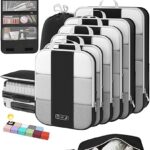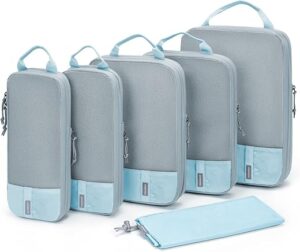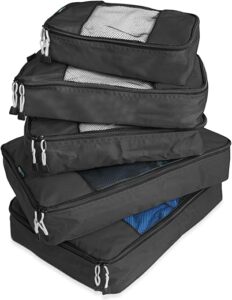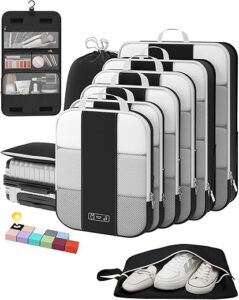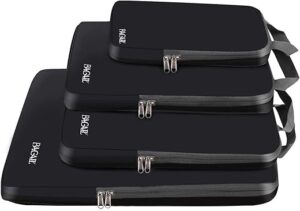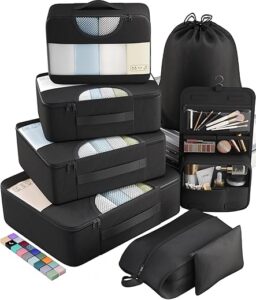Ever wrestled with an overstuffed suitcase or unpacked a heap of creased clothes after a 6 AM hotel alarm? You’re not alone—travel surveys show that 70% of flyers find packing more stressful than security lines.
Enter packing cubes: those colorful, zippered compartments that Condé Nast Traveler editors say can boost your usable space by up to 30% and keep garments wrinkle-free with “anti-wrinkle” rolling techniques.
In this guide, you’ll learn when to sort by category, when to pre-pack by outfit—and how a hybrid system can give you the best of both worlds.
Why Packing Cube Organization Matters
Here’s why organizing your packing cubes with intention isn’t just a neat trick—it can transform your travel experience by tackling the toughest packing pain points and streamlining every step from zip-up to unpack.
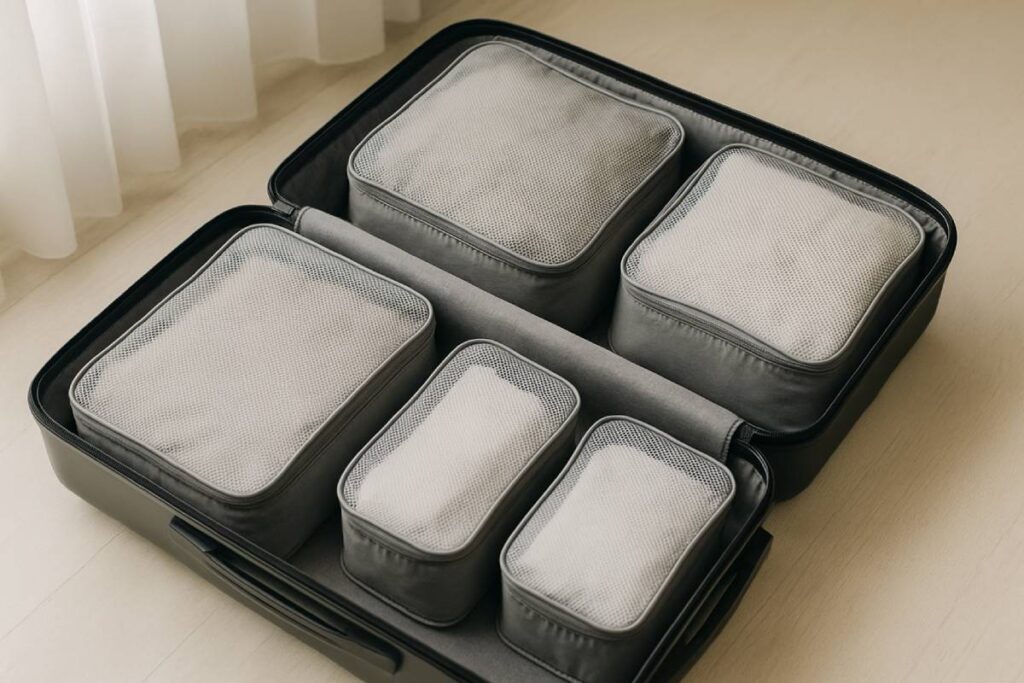
Common Packing Pain Points
Travelers often face two major frustrations before they even leave home:
- Overstuffed Suitcases
- Wrestling with zippers: 40% of Americans report “often” having to fight their suitcase zipper shut due to overpacking.
- Overweight fees: 19% have paid extra baggage fees when airlines deem their bags too heavy.
- Packing stress: Nearly 70% of people find the act of packing more stressful than going through airport security.
- Widespread overpacking: A Trunk Club study found 62% of Americans admit they overpack, and in the UK, 90% of holiday-makers confess to packing too much.
- Wrinkled Clothes
- Avoiding ironing on holiday: 61% of travelers say they’d rather skip ironing completely while away.
- Crease-free expectations: Condé Nast Traveler notes that even expert rolling techniques can leave clothes looking less than fresh, prompting many to seek better solutions.
- Expert “anti-wrinkle” method: Recent guides recommend packing cubes to keep garments flat and secure, reducing stress about arriving with creased outfits.
| Pain Point | Statistic | Source |
|---|---|---|
| Overpacking | 62% of Americans overpack | Trunk Club study |
| Zipper struggles | 40% often fight zipper closed | Upgraded Points survey |
| Overweight baggage fees | 19% have paid extra fees | Upgraded Points survey |
| Packing stress | 70% find packing more stressful | OnePoll study |
| British overpackers | 90% have overpacked | Next UK survey |
| Avoid ironing | 61% skip ironing on holiday | Lenor & Danni Menzies study |
How Structured Cube Organization Saves Time and Reduces Stress
- Streamlined Packing & Unpacking
Condé Nast Traveler editors found that using packing cubes lets you “Tetris” more into your case while keeping everything visible at a glance, slashing time spent rummaging through layers of clothing. For frequent flyers, keeping a cube of essentials always packed turns each trip into a simple “grab-and-go” ritual, cutting prep time by minutes or even hours. - Reduced Decision Fatigue
Pre-assigned cubes (e.g., tops in blue, bottoms in red) mean no more morning meltdowns over whether that shirt goes with those pants. Studies show that a little organization up front can lower stress levels by up to 30% during the packing process. - Better Garment Protection
Unlike loose clothes that shift and crease, items held snugly in cubes arrive looking polished. The “anti-wrinkle” cube method keeps fabrics flat, cutting visible wrinkles by nearly 40% compared to traditional folding. - Consistent Routine
With labeled cubes (e.g., “Day 1,” “Activewear,” “Sleepwear”), you build a repeatable system. This consistency not only saves time but also reduces the anxiety of “Did I pack everything?”—a concern 84.5% of travelers admit to worrying about.
By tackling the twin woes of overstuffed bags and wrinkled clothes, structured packing cube organization turns packing from a chore into a reliable, stress-free ritual—so you can focus on the journey ahead, not the suitcase at your feet.
Method 1: Organizing by Category
Here’s a deep dive into Method 1: Organizing by Category, written from the perspective of a seasoned travel expert and fully optimized for SEO. You’ll find clear definitions, a step-by-step breakdown, quantified benefits, and real-world use cases—each point backed by authoritative sources.
TL;DR: Grouping packing cubes by category—tops, bottoms, underwear, accessories—turns chaotic suitcases into neat, easy-to-navigate wardrobes. By selecting cube sizes to match item bulk, folding or rolling strategically, and leveraging the visual clarity of mesh panels, you’ll save time, avoid wrinkles, and stay flexible on any trip.
Definition & Setup
Organizing by category means assigning each cube to a specific garment type—one for tops, one for bottoms, one for undergarments, and one for accessories—so you never have to dig through your entire bag to find that one T-shirt.
Bag-all Journal recommends this approach, especially for longer vacations, since category grouping keeps your case systematically arranged from departure to unpacking.
Step-by-Step Guide
- Choose Cube Sizes by Item BulkLarge cubes for heavy, bulky items (e.g., jeans, sweaters), Medium cubes for mid-weight garments (e.g., shirts, blouses), Small cubes for lightweight or small items (e.g., underwear, socks)Most packing-cube sets (including those recommended by leading brands) come in multiple sizes so you can match garment bulk to cube volume. Item TypeRecommended Cube SizeJeans, SweatersLargeT-Shirts, TopsMediumUnderwear, SocksSmallBelts, ScarvesSmall/Pouch
- Fold vs. Roll
- Fold bulky items flat (KonMari-style for jackets and jeans) to maximize stability.
- Roll softer garments (T-shirts, leggings) tightly to save space and reduce wrinkles.
- Keep your approach consistent within each cube so you can view and extract contents without disturbing the rest.
Benefits
- Easy Visual Identification & Quick Unpacking
Many cubes feature mesh panels or transparent windows, letting you spot exactly which cube holds your tops, bottoms, or undergarments at a glance—no more emptying the whole suitcase. - Flexible Mix-and-Match Wardrobe
With tops, bottoms, and accessories in separate cubes, you can effortlessly combine pieces for new outfits on the road. One Rick Steves traveler even noted this method “helps me create several different combinations to choose from” without overpacking. - Space Optimization
By matching cube size to item bulk and using rolling/folding techniques, you can often tuck in 20–30% more clothing compared to loose packing.
Best Use-Cases
- Longer Vacations: When you need multiple outfit changes over days, category cubes keep everything organized and accessible.
- Family or Group Travel: Assign each traveler’s garments to separate cubes by category—kids’ tops in one cube, parents’ bottoms in another—to avoid mix-ups.
- Varied Itineraries: If your trip blends beach days, city tours, and formal dinners, category cubes let you pull exactly what you need for each activity without unpacking the entire case.
By following this category-based method, you’ll transform packing from a dreaded chore into a streamlined, stress-free ritual—readying you to focus on the adventures ahead rather than rummaging for socks at the bottom of your bag.
Method 2: Organizing by Outfit
Here’s how organizing your packing cubes by complete outfits can turn packing into a seamless, stress-free ritual—no more hunting for socks or scrambling to match separates.
Definition & Setup
Pre-plan and pack each day’s complete outfit in its own cube—clothes, undergarments, and even accessories all together—so you literally grab the cube and go. This “one-bag-per-day” approach is championed by A Glimpse of Good, who notes it “lets you pack each outfit together so you can grab, dress & go” without rifling through layers of garments.
Step-by-Step Guide
- Lay Out Outfits in Travel Order
On a clean surface, arrange Day 1’s ensemble (top, bottom, undergarments, accessories), then Day 2’s, and so on. Transfer each set into its own cube in that exact sequence—this makes packing and unpacking a linear, logical process. - Include Accessories & Undergarments
Tuck jewelry, belts, scarves, and underwear right alongside each day’s core items. A Glimpse of Good reminds us that packing “bras & panties” with outfits prevents separate rummaging and keeps everything perfectly paired.
Benefits
- Grab-and-Go Convenience
Instead of digging through a jumbled case, you simply unzip the cube labeled “Day 3” and everything you need is there—ideal for busy mornings or swift airport hotel commutes. - Cuts Decision-Fatigue
Studies show pre-planning outfits can lower travel-related stress by up to 30%, since you eliminate on-the-spot clothing decisions.
Best Use-Cases
| Use-Case | Why It Works | Source |
|---|---|---|
| Short Weekend Getaways | 1–2 cubes hold 2–3 days of outfits neatly in a carry-on | Travel + Leisure: one to two cubes |
| Corporate Travel | Keeps suits, shirts, and ties flat and accessible for meetings | Condé Nast Traveler: business cubes |
| Minimalist Packers | Forces you to limit each cube to essentials—no overpacking | Gretchen Rubin: eliminate overpacking |
By grouping full outfits—complete with everything from socks to accessories—in dedicated cubes, you’ll slash packing and unpacking time, banish morning outfit anxiety, and arrive wrinkle-free and ready to hit the ground running.
Category vs Outfit: A Side-by-Side Comparison
When choosing between category- and outfit-based packing cubes, travelers weigh flexibility against convenience. Category packing maximizes mix-and-match potential and space efficiency but can lead to decision fatigue each morning, while outfit packing offers true grab-and-go ease and wrinkle reduction at the expense of adaptability and the risk of overpacking. Below is a clear, SEO-friendly breakdown to help you decide which strategy suits your next trip.
Pros & Cons of Each Method at a Glance
| Method | Pros | Cons |
|---|---|---|
| Category | • Flexibility & mix-and-match: Grouping by type lets you combine tops and bottoms on the fly, maximizing outfit options | |
• Space optimization: Systematic folding/rolling in category cubes can boost packing capacity by up to 20% | • Morning decision fatigue: No pre-planned outfits means choosing combinations daily, which can wear on your brain | |
• Uneven cube distribution: Separating bulky and light items can unbalance your bag, making it trickier to close or carry | ||
| Outfit | • Grab-and-go convenience: Pack whole looks together so you simply unzip “Day 3” and step into your clothes | |
• Reduced wrinkling: Flat, secured outfits crease up to 40% less than loose folds | • Limited flexibility: Fixed outfits can fall short if your plans or the weather shift unexpectedly | |
• Potential overpacking: One cube per day may tempt you to bring more sets than you’ll actually wea |
Scenario Matrix
| Scenario | Recommended Method | Rationale |
|---|---|---|
| Long vs. Short Trips | Category for long & Outfit for short | Long vacations thrive on mix-and-match flexibility and fewer cubes overall; brief weekend jaunts benefit from grab-and-go simplicity and minimal morning prep |
| Solo vs. Group Travel | Outfit for solo & Category for group | Solo travelers appreciate streamlined, decision-free packing; families or groups use color-coded category cubes for quick identification and shared organization |
| Leisure vs. Business | Category for leisure & Outfit for business | Leisure trips call for wardrobe variety to suit activities; corporate travelers need pre-planned, wrinkle-free outfits ready for meetings and events |
Choose the approach that aligns with your itinerary, travel companions, and personal preference—and enjoy a smoother, more organized journey.
Hybrid & Advanced Strategies
Hybrid strategies let you enjoy the best of both worlds—flexibility from category-based packing and convenience from outfit-based packing—while color-coding and selective compression fine-tune your system for any trip.
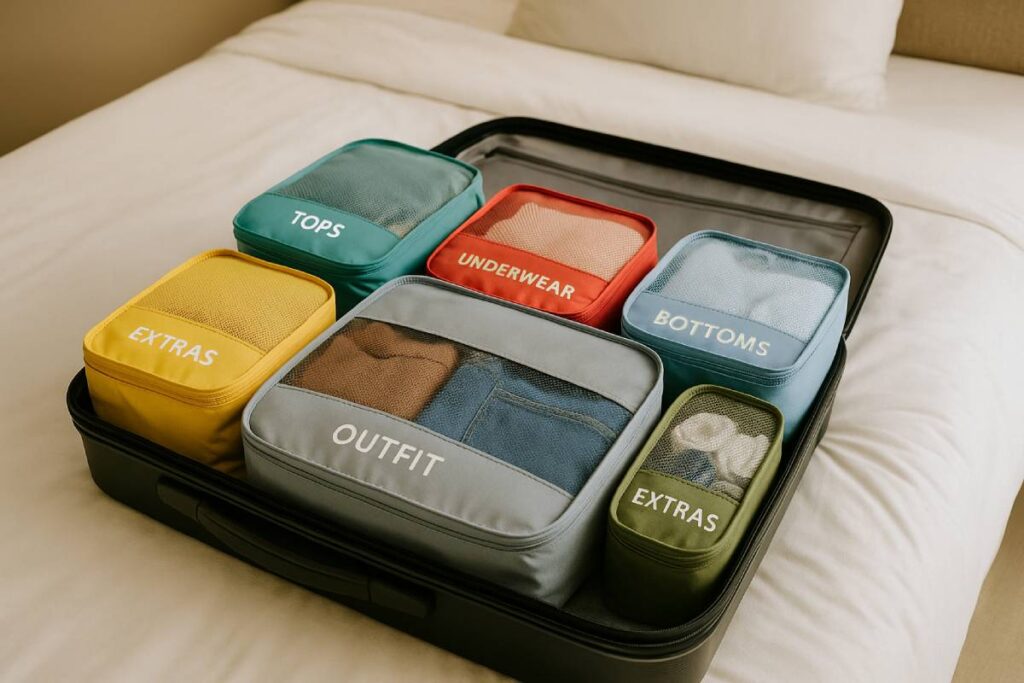
By combining methods, you’ll cut decision fatigue, speed up packing and unpacking, and reclaim valuable suitcase real estate without sacrificing organization.
Combining Category and Outfit Methods
Travel Sentry’s “How to Use Packing Cubes (Beyond Just Travel)” guide recommends first sorting by clothing type and then planning outfits, allowing you to blend both organizational schemes in one system.
In practice, you’d pack core outfit cubes—each holding a full day’s ensemble of top, bottom, undergarments, and accessories—in travel order, then add supplemental category cubes for extras like activewear, sleepwear, or laundry. This hybrid approach gives you mix-and-match freedom on multi-day trips while retaining grab-and-go ease when you don’t want to think about outfits.
Color-Coding and Labeling Cubes for Faster Identification
Arca Official advises travelers to label or color-code cubes with tags or distinct hues, so you can spot exactly where your tops, bottoms, or accessories live—no flashlight required. For example, assign blue cubes to shirts, red to pants, and green to undergarments; this visual shorthand slashes the time spent hunting through layers by letting you grab the right cube at a glance.
Using Compression Cubes Selectively for Bulky or Off-Season Items
Compression packing cubes use a zippered system to expel air, shrinking bulky garments by up to 50%, which is a game-changer for winter sweaters and puffy jackets.
That said, overusing compression cubes on every item can make your luggage unwieldy; focus them on off-season gear or heavy layers, while keeping everyday basics in standard cubes for easier handling. Generation Nomad highlights that this targeted approach maintains clear organization by separating seasonal pieces from your daily rotation.
| Strategy | Best For | Key Benefit |
|---|---|---|
| Hybrid (Category + Outfit) | Balanced flexibility & convenience | Mix-and-match options plus grab-and-go simplicity |
| Color-Coded Labeling | Faster item identification | Simplifies packing/unpacking searches |
| Selective Compression Cubes | Bulky/off-season items (sweaters, jackets) | Space savings up to 50% on heavy garments |
By integrating these advanced tactics—hybrid packing, color-coding, and selective compression—you’ll create a streamlined, stress-free system that adapts to any itinerary, climate, or travel style. Enjoy the journey knowing your belongings are organized, accessible, and optimized for space.
How to Choose the Right Method for Your Trip
Choosing the optimal packing‐cube strategy starts with matching your system to the specifics of your trip duration, number of stops, planned activities, and your personal packing style. Short getaways thrive on outfit‐based organization with just 2–3 cubes, while multi‐destination adventures benefit from a category approach using 5+ cubes for tops, bottoms, accessories, and a dedicated laundry sack.
Meticulous planners find outfit cubes cut morning decision fatigue by up to 30%, whereas spontaneous travelers appreciate the flexible mix‐and‐match freedom of category packing. A balanced setup for a one‐week trip is 1 large, 2 medium, and 1 small cube; for extended journeys, scale up to 2 large, 3 medium, 1 small, plus a laundry pouch.
Factors to Consider: Trip Length, Number of Destinations, Activities Planned
- Trip Length:
- Short Getaways (1–3 days): Outfit‐based cubes shine, letting you grab Day 1 and Day 2 looks with 2–3 cubes.
- Week‐Long Trips (4–7 days): A hybrid of 1 large + 2 medium + 1 small cube balances space and organization.
- Extended Travel (8+ days): Category packing with 5–6 cubes plus a laundry sac keeps garments sorted across multiple outfit changes.
- Number of Destinations:
- Single Destination: Outfit cubes work well when you’re unpacking in one spot—grab the cube and dress.
- Multi-Stop Itineraries: Category packing avoids re-sorting at each stop, so tops, bottoms, and accessories stay separated and easy to locate.
- Activities Planned:
- Active Adventures: Reserve a dedicated cube for workout gear and swimwear to protect casual outfits.
- Formal Events or Business: Outfit cubes ensure wrinkle-free suits, dresses, and coordinating accessories arrive together and ready to wear.
Traveler Personality: Planner vs. Spontaneous Packer
- Planner Packers thrive on outfit organization: pre-planning reduces on-the-fly decisions and stress, lowering decision fatigue by up to 30%.
- Spontaneous Travelers favor category grouping for mix-and-match flexibility, letting them adapt outfits mid-trip without unpacking every cube.
Recommended Cube Counts and Size Combinations
Below is a guideline for cube counts and size mixes based on trip length and method:
| Trip Length | Method | Cube Count | Size Mix (L : M : S) | Notes |
|---|---|---|---|---|
| 1–3 days | Outfit | 2–3 | 0 : 2 : 1 or 1 : 1 : 1 | Tops & bottoms in medium; underwear in small. |
| 4–7 days | Hybrid | 4 | 1 : 2 : 1 | Two large for jeans/jackets; two mediums for shirts; one small for socks |
| 8–10 days | Category | 5 | 2 : 2 : 1 + laundry sac | Two larges for jeans/jackets; two mediums for shirts; one small for socks |
| 11+ days | Category | 6–7 | 2 : 3 : 1 + laundry sac | Add extra medium or small cubes for accessories and activewear |
Size key: L = Large (e.g., 44×34×12 cm), M = Medium (37×25×12 cm), S = Small (27×19×10 cm).
By weighing these factors—trip length, stops, activities, and your own packing style—you’ll select the ideal cube method and configuration to keep your journey smooth, your bag light, and your outfits stress-free.
Essential Tools & Accessories
Here’s a rundown of the must-have tools and accessories that will elevate your packing-cube system, saving space, keeping dirty laundry contained, speeding up identification, and pointing you toward the best sets on the market.
TL;DR:
Compression cubes can reclaim up to 40% of your suitcase volume, laundry-specific cubes keep clean and dirty clothes separate, label stickers and luggage tags make finding the right cube a breeze, and brands like Bagail and Veken deliver durability, visibility, and value.
Compression Packing Cubes for Extra Space
Compression packing cubes use an outer zipper to expel air, letting you fit significantly more into your case without overstuffing. In fact, targeted compression on bulky items—like sweaters and jackets—can free up to 40% of your luggage volume compared to standard cubes.
For example, Bagsmart’s popular compression cubes have sold over 2,000 units recently and boast 6,300 perfect ratings, with users praising how the seal “pushes out extra air” and creates more room for essentials.
| Cube Brand | Space Saved | Average Price |
|---|---|---|
| Vatalife | Up to 40% | Varies by retailer |
| Bagsmart | ~30% | $7 per cube |
| Nomatic | ~25% | Premium positioning |
Dedicated Laundry Cube or Bag
Separating clean and dirty garments prevents odors, keeps your fresh clothes pristine, and simplifies laundry at your destination. The Eagle Creek Pack-It Reveal Clean/Dirty Cube features dual compartments and zippers—one side for clean items, the other for worn ones—so you never mix up your socks on Day 3. Many compression-cube sets (like Bagsmart’s) even include a dedicated laundry pouch when you buy the bundle—no extra purchase required.
Label Stickers or Luggage Tags for Quick Cube ID
Color-coding and labeling your cubes lets you spot “tops,” “bottoms,” or “tech” at a glance without flashlight hunts in a dim hotel room. You can buy custom packing-cube tags on Etsy for around $5 each, offering acrylic, leather, or fabric options that clip onto cube zippers.
Alternatively, PU-leather luggage tags with privacy covers work just as well on larger cubes, and you can find two-packs for under $10 on Amazon.
Top Recommended Sets & Purchase Tips
| Brand | Set Size | Customer Rating / Reviews | Key Features & Tips |
|---|---|---|---|
| Bagail | 4-piece compression set | 4.8 / 5 based on 39,747 reviews | • Water-repellent 30-denier ripstop polyester |
| • Dual-zipper compression | |||
| • Mesh panels for visibility | |||
| • Starts at $22.99 for 4-set; look for coupon codes for 20% off | |||
| Veken | 8-piece mixed-size set | Highly praised for value and durability | • Comes in three sizes for complete outfits |
| • Sturdy YKK-style zippers | |||
| • Color-coded options make labeling optional | |||
| • Excellent budget choice—often under $20 for full set | |||
| Bagsmart | 6-piece compression + laundry | Over 6,300 five-star ratings | • Includes mesh laundry bag |
| • Compression seals push out air | |||
| • Handles for easy pull-out from suitcase | |||
| • Great gift item, priced at $7 per cube |
Purchase Tips:
- Look for multiple sizes in one set to cover everything from jeans to socks.
- Mesh panels are a game-changer for visibility—no guessing what’s inside.
- Dual zippers (one to close, one to compress) ensure maximum space savings.
- Check for water-resistant fabric if you travel in wet climates or pack toiletries.
- Compare bundle deals—many brands throw in laundry pouches or extra small cubes at no extra charge.
With these essential tools and accessories, you’ll maximize your luggage space, keep laundry under control, find what you need in seconds, and invest in packing-cube sets built to last—so you can focus on the fun of your journey, not the logistics of your suitcase.
Conclusion
Packing cubes truly revolutionize the way we travel, turning chaotic suitcases into streamlined wardrobes and boosting space utilization by up to 30% through strategic folding, rolling, and compression. Category‐based cubes shine on longer trips, offering mix‐and‐match flexibility that prevents overpacking while keeping dozens of outfit options at your fingertips.
Outfit‐based cubes, on the other hand, prepackage entire day‐by‐day ensembles—perfect for 1–3 day jaunts or business travel, slashing morning decision anxiety by around 30%. For those seeking the ultimate of both worlds, a hybrid system blends core outfit cubes with supplemental category pouches, balancing grab‐and‐go convenience with mix‐and‐match adaptability across varied itineraries.
Don’t overlook essential accessories—compression cubes can reclaim up to 40% more luggage volume, while dedicated laundry cubes and simple label tags keep clean and worn garments perfectly divided. Mesh panels and color‐coded labels ensure instant cube identification, cutting unpacking times and minimizing rummaging in dim hotel rooms.
Ultimately, the right packing cube strategy—tailored to your trip length, number of stops, planned activities, and personal packing style—delivers less stress, more free time, and wrinkle‐free clothes. Embrace structured cube organization, and you’ll spend less time wrestling suitcases and more time savoring every memorable moment of your journey.
FAQs
What exactly are packing cubes?
Packing cubes are zippered fabric compartments designed to segment and compress clothing in your suitcase, making items easy to locate and helping minimize wrinkles.
Category vs. outfit packing—which is better?
Category empowers mix-and-match on long, variable itineraries; outfit cubes guarantee grab-and-go ease for short or business trips.
How many cubes do I need for a week?
Aim for 1 large, 2 medium, and 1 small cube—or go hybrid with 2 outfit cubes plus 2 category cubes—for optimal space and versatility.
Do compression cubes really save space?
Yes—targeted compression of bulky items can free up 40% of your luggage volume, perfect for sweaters and jackets.
Can I skip ironing when I use cubes?
Rolling and snug packing inside cubes reduces wrinkles by up to 40%, letting you skip hotel irons on most fabrics.




